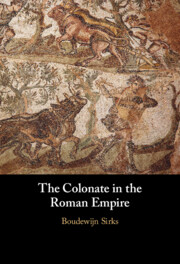Book contents
- The Colonate in the Roman Empire
- The Colonate in the Roman Empire
- Copyright page
- Contents
- Introduction
- Chapter 1 The Colonate in the East under Justinian, 527/534–565/642
- Chapter 2 The Colonate in the Year 438 in Theodosius’ Code
- Chapter 3 The Colonate in the East, 438–527
- Chapter 4 The Colonate in the West, 438–ca. 506
- Chapter 5 The Colonate between Theodosius’ Code and Diocletian and the Third Century, 438–293/268/249
- Bibliography
- Index Locorum
- General Index
Chapter 3 - The Colonate in the East, 438–527
Published online by Cambridge University Press: 04 January 2024
- The Colonate in the Roman Empire
- The Colonate in the Roman Empire
- Copyright page
- Contents
- Introduction
- Chapter 1 The Colonate in the East under Justinian, 527/534–565/642
- Chapter 2 The Colonate in the Year 438 in Theodosius’ Code
- Chapter 3 The Colonate in the East, 438–527
- Chapter 4 The Colonate in the West, 438–ca. 506
- Chapter 5 The Colonate between Theodosius’ Code and Diocletian and the Third Century, 438–293/268/249
- Bibliography
- Index Locorum
- General Index
Summary
The transmission of the condicio coloniaria appears determined by the characterisation of it as a lesser status and the senatusconsultum Claudianum used as correction. But this was not restricted to coloni. Other groups involved in an industry important for the emperor (weapon smiths, silk weavers, purple snail divers, miners, minters) were also tied and subjected, as the corporati of towns, important for the municipal services (fire men, etc.). The term condicionales is used. However, from the enumeration it follows that the lesser status, which also impeded the fulfillment of official functions, was restricted to these groups and was not a general phenomenon.
Keywords
- Type
- Chapter
- Information
- The Colonate in the Roman Empire , pp. 240 - 248Publisher: Cambridge University PressPrint publication year: 2024

